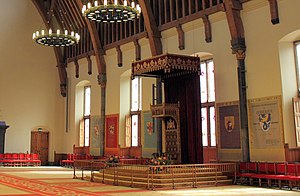
Juliana was Queen of the Netherlands from 1948 until her abdication in 1980.
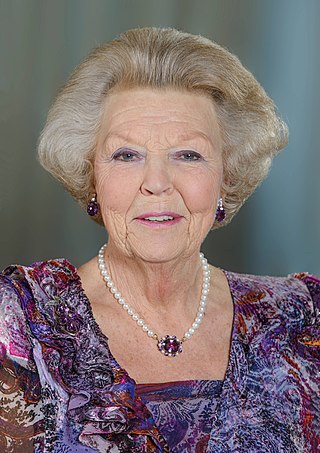
Beatrix is a member of the Dutch royal house who reigned as Queen of the Netherlands from 1980 until her abdication in 2013.

Princess Christina of the Netherlands was the youngest of four daughters of Queen Juliana of the Netherlands and Prince Bernhard of Lippe-Biesterfeld. She taught singing in New York and was a long-term supporter of the Youth Music Foundation in the Netherlands. Born visually impaired, she worked to share her knowledge of dance and sound therapy with the blind.

Princess Margriet of the Netherlands is the third daughter of Queen Juliana and Prince Bernhard. As an aunt of the reigning monarch, King Willem-Alexander, she is a member of the Dutch Royal House and currently eighth and last in the line of succession to the throne.

Pieter van Vollenhoven Jr. is the husband of Princess Margriet of the Netherlands and a member, by marriage, of the Dutch royal house.

Prince Maurits Willem Pieter Hendrik of Orange-Nassau, van Vollenhoven is a member of the Dutch royal family as the eldest son of Princess Margriet of the Netherlands and Pieter van Vollenhoven.

Count Claus-Casimir of Orange-Nassau, Jonkheer van Amsberg, is the second child of Prince Constantijn and Princess Laurentien of the Netherlands and their only son. He is a member of the Dutch royal family and is sixth in the line of succession to the Dutch throne.
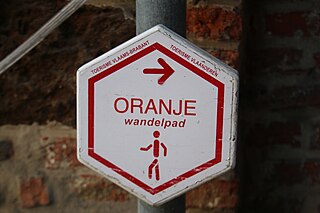
In the Kingdom of the Netherlands, the monarchy of the Netherlands is a constitutional office and is controlled by the Constitution of the Netherlands. A distinction is made between members of the royal family and members of the royal house.

Prince Pieter-Christiaan Michiel of Orange-Nassau, van Vollenhoven, is the third son of Princess Margriet of the Netherlands and Pieter van Vollenhoven.

Prince Floris Frederik Martijn of Orange-Nassau, van Vollenhoven is the fourth and youngest son of Princess Margriet of the Netherlands and Pieter van Vollenhoven.

Prince Bernhard Lucas Emmanuel of Orange-Nassau, van Vollenhoven is a Dutch entrepreneur and a member of the Dutch royal family.

The Order of the Gold Lion of the House of Nassau is a chivalric order shared by the two branches of the House of Nassau.

The House of Lippe-Biesterfeld was a comital cadet line of the House of Lippe.

The monarchy of the Netherlands is a constitutional monarchy whose role and position are governed by the Constitution of the Netherlands. Roughly a third of the Constitution explains the succession, mechanisms of accession and abdication to the throne, the roles and duties of the monarch, the formalities of communication between the States General of the Netherlands, and the monarch's role in creating laws.
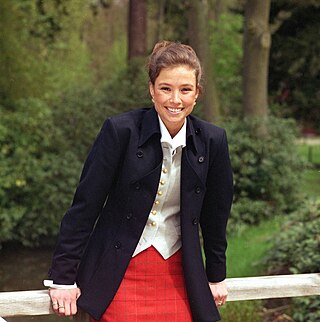
Princess Marilène of Orange-Nassau, van Vollenhoven-van den Broek is the wife of Prince Maurits of Orange-Nassau, van Vollenhoven, and was thereby member of the Dutch Royal House until King Willem-Alexander's accession in 2013 rendered Prince Maurits too distantly related to the reigning monarch. She remains a member of the larger Dutch royal family.
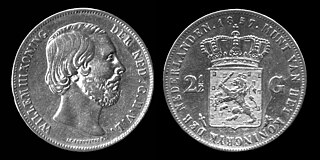
The style of the Dutch sovereign has changed many times since the establishment of the Kingdom of the Netherlands due to formations and dissolutions of personal unions, as well as due to marriages of female sovereigns and cognatic successions.
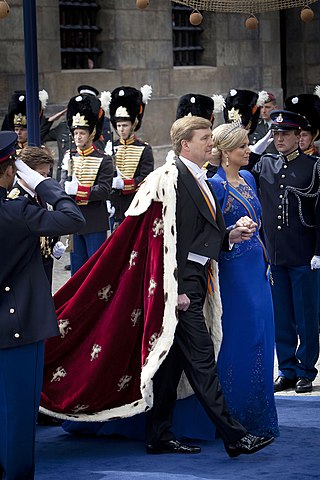
The inauguration of Willem-Alexander took place on 30 April 2013 at the Nieuwe Kerk in Amsterdam. Willem-Alexander ascended the throne immediately following the abdication of his mother Queen Beatrix earlier that day. Willem-Alexander is the first King of the Netherlands since the death of his great-great-grandfather William III in 1890.
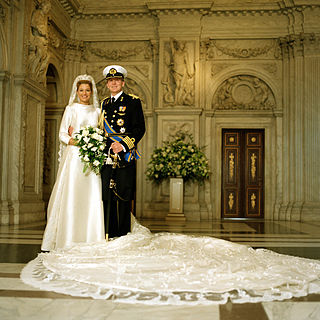
The wedding of Willem-Alexander, Prince of Orange, and Máxima Zorreguieta Cerruti took place on 2 February 2002 at the Nieuwe Kerk, Amsterdam. Willem-Alexander and Máxima became king and queen on 30 April 2013 after the abdication of his mother, Beatrix.

The inauguration of Beatrix as Queen of the Netherlands took place on 30 April 1980 at the Nieuwe Kerk in Amsterdam. Beatrix ascended the throne immediately following the abdication of her mother Juliana earlier that day.
